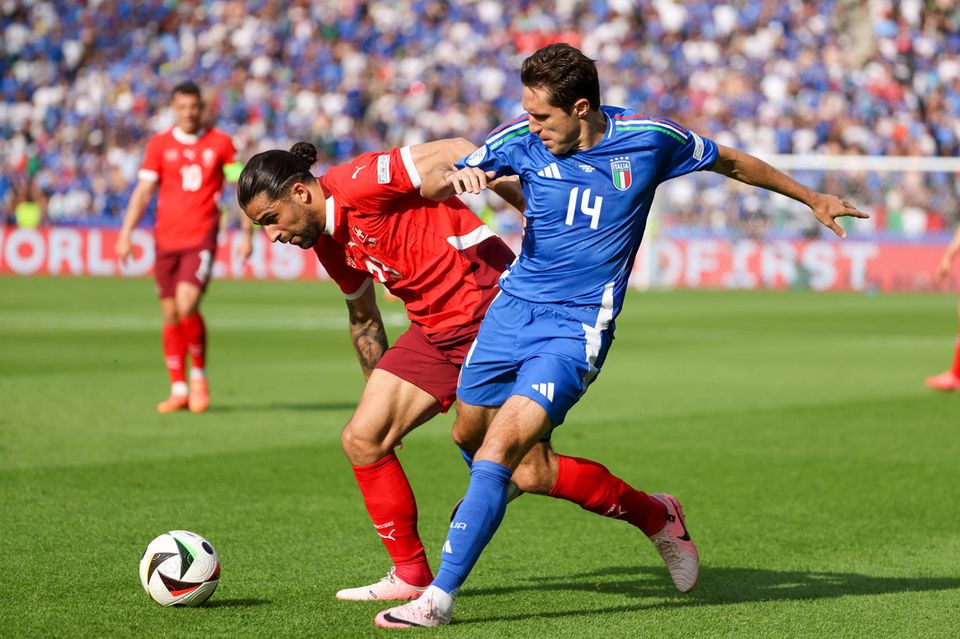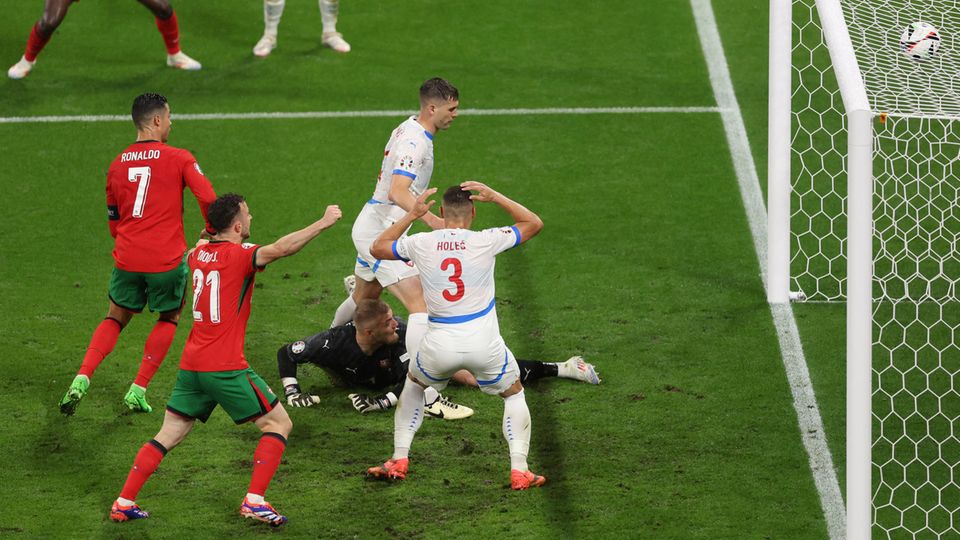The lack of success of the strikers or the rediscovery of long-range shots are just two aspects of the Euro 2024 that tactics expert Tobias Escher has identified. He explains why, for him, modern football like “Starbucks” is.
Tobias Escher is co-founder of the website Spielverlagerung.de, which covers numerous topics relating to football tactics. As one of the most respected experts in this field, he writes for various media outlets.
Here he looks back on the European Championship 2024 so far with nine observations – from tired players to the flood of own goals to the young stars who have competition have shaped.
The atmosphere was good, but the big football spectacle was missing
Full stadiums, full fan zones: The atmosphere at this tournament was fantastic. Unfortunately, the football wasn’t always that great. Most teams played from a reinforced defensive position. On average, there were only 2.28 goals per game up to the final – a decrease of 0.5 compared to the last tournament. In both semifinals there were only 15 shots on goal. These are very low figures. One reason: the tournament format. In the preliminary round, the best third-placed teams in the group also advance; if necessary, three draws are enough. There is no pressure to win.
In the knockout rounds, there is the option of a penalty shootout in extra time, and it is then very difficult to make up a deficit. The consequence: risk minimization, deep lines, no high pressing – not attractive football. Top nations such as England, France and Belgium also played with coaches who always loved the defensive. The Netherlands also played cautiously, with no trace of the earlier hurrah football. At least there was also the offensive faction: Spain, Germany, Turkey in some parts – and the surprise team from Austria.
The 2024 European Championship was the tournament of great exhaustion
Bloated competitions, more and more games, especially for the top clubs – at the end of the season many players are at the end of their strength: physically and mentally. And they went to the European Championships in this condition. There were less than two weeks between the Champions League final at the beginning of June and Germany’s opening match. You can’t expect any more gala performances.
Florian Wirtz had a great season in the Bundesliga and not a bad European Championship either – but not a really good one either. England’s Harry Kane had to be taken off the pitch ten minutes before the end of the semi-final despite the possibility of extra time because he was exhausted. Many matches became battles of attrition and attrition, not football festivals – also because the coaches reacted to the circumstances: safety instead of risk, simple concepts instead of tactical finesse, avoiding deficits wherever possible.
Man-to-man coverage is suddenly back in fashion
For years, man-marking was frowned upon as old-fashioned and uncreative: Each player was assigned an opponent whom he had to watch out for throughout the game. Coaches who were serious about their work chose zone marking instead, in which each player was responsible for precisely defined zones on the pitch. Surprisingly, there was a retro trend at this European Championship. In the quarter-finals against Spain, Germany played man-marking across the entire pitch. Switzerland shocked Italy in the round of 16 with man-marking and threw the “Blue Squad” from the tournament. The Turkish team also provoked a lot of man-to-man duels.

This posed major problems for the opponents. When I play man-to-man, I need a lot of movement: Individual personal guards have to be lured out of the defensive block again and again through evasive and diversionary maneuvers, so that the spaces thus freed up can then be filled with teammates at lightning speed. This requires a lot of effort – and could be the ulterior motive for the renaissance of man-to-man coverage. The goal: to force the opponent to put in a lot of effort at the end of a long, exhausting season.
Modern football is like “Starbucks”: There are many branches. But they all look the same
Globalization is leveling out national peculiarities and cultural differences. This also applies to football, especially since many players now play in very few top European leagues in England, Spain, Germany or Italy. Almost every team at this European Championship chose the game build-up variant taught by the Spanish coaching maestro Pep Guardiola: with three defenders and one or two midfielders in front of them.
There is a great uniformity of approaches – the “Starbuckization” of football: different branches, but ultimately it looks the same everywhere. You can no longer tell at first glance, as you used to: This must be a Belgian, Czech or Romanian team. Germany no longer plays typical German football, but – thanks to Julian Nagelsmann – the modern, globalized football that almost everyone plays.
The most important tactical innovation: full-backs become key players
Attacking full-backs have been around for a long time, but their role was redefined at this tournament. Together with an advancing midfielder and the respective winger, the full-back forms a triangle in which quick passing combinations are used to free up the winger, who can then deliver precise crosses into the penalty area without any pressure from the opposition. If one side of the attack is thus “overloaded”the opponent has to react and move his players in that direction. With a quick diagonal pass to the other, now exposed side, the game can be opened up wonderfully.
Or, also seen very often at the European Championships: the full-back suddenly moves inwards with the ball, which moves the defensive block and causes mistakes. The defender, who has mutated into an attacker, then either looks for his winger again, or he plays a short, deadly through ball into the center of the defense, or he tries to score from the edge of the penalty area himself. This range of variation did not exist in the past, when offensive full-backs mostly stuck stubbornly to the sideline. The Spanish (with Cucurella, Olmo and Williams) and the English (with Walker, Saka and Foden) demonstrated this tactical device to perfection. This is perhaps one of the reasons why both reached the final.
The long-range shot was rediscovered
In the preliminary round, every fifth shot was a long-range shot outside the penalty area. This is significantly more than in the Bundesliga, where only about every tenth shot is fired from a distance. For years, it was fashionable to play a neat short passing game right up to the “box”rather than close to the opponent’s goal – which makes sense, because statistically speaking, it takes a relatively large number of attempts to score a goal with long-range shots. But national teams don’t have the training time that club teams have to practice automatic moves. The long-range shot is a tried and tested method when no other solutions can be found in the final third in front of the opponent’s goal.
In addition, the defensive formations are not as well practiced in a tournament as they are in everyday league play. A typical example: Xavi Simons’ hammer shot that gave the Dutch a 1-0 lead in the semi-final against England. In the Bundesliga, a defender would have immediately come out to block the shot. Against England, however, Simons had a clear path. And collective exhaustion may also play a role here. When there is no more energy, complex attacking efforts are often ended earlier with a long-range shot.
Own goals are piling up
This is not a completely new trend, as there was already a flood of own goals at the last European Championships. Of all the own goals scored at European Championships since 1960, around 70 percent have come in the last three tournaments alone, although there are also more games per European Championship than before. Why so many own goals? The following was often seen: a flat or half-high cross into the penalty area, a very sharp shot, a defender not getting his bearings properly – and the ball accidentally ends up in his own goal.

Possibly own goals have become part of the tactical toolkit and are deliberately provoked. First I play the defence apart, then I make the sharp cross. If the defenders aren’t sure whether there is an attacker lurking behind them, they have to clear the ball somehow – and they have to do this in the middle of moving forward towards their own goal. This is how the classic own goal of this European Championship comes about. And situations like this can be brought about.
It was not the tournament of the strikers
No one stood out among the classic attackers. Sure, Kai Havertz and Niclas Füllkrug scored – but overall it was not a tournament for strikers. Classic penalty area strikers like Füllkrug, Wout Weghorst for the Dutch or Olivier Giroud for the French, were often substituted late and in dire need. Harry Kane often played deep in midfield for England, in positions that would otherwise be the “10” or even the “6”that is, someone like Toni Kroos. Even for Spain, Morata was worn out in the middle of the attack.
The goal threat at this European Championship came more from the midfield, from players who suddenly moved up like Musiala (Germany), Rodri (Spain), Belllingham (England) – or even from the full-backs. There were very few teams that tried to feed their strikers with crosses in the penalty area. The motto was more: only send high crosses when the others are worn out or we are running out of time – in other words in the final phase of the game.
Ronaldo and Co. step down – the “Jugend forscht” generation takes over
Cristiano Ronaldo, Pepe, Luka Modrić, Toni Kroos – the big, old names in football wanted to put their stamp on the tournament once again. And ultimately had to leave the field, often in tears. Because this European Championship was a triumph for the younger generation. The Spanish wing pairing of Lamine Yamal (16) and Nico Williams (21): youthful recklessness paired with determination in front of the goal.
Jude Bellingham, rarely brilliant, but very important for England: just turned 21. His hooking teammate on the right wing, Bukayo Saka: 22 years young. The Spaniard Dany Olmo, match winner against Germany: at 26, in his prime footballing age. The generation “Youth research” set the highlights of this European Championship – and pushed the old ones off the stage.
Recorded by star-Author Tilman Gerwien.
Source: Stern
I am Pierce Boyd, a driven and ambitious professional working in the news industry. I have been writing for 24 Hours Worlds for over five years, specializing in sports section coverage. During my tenure at the publication, I have built an impressive portfolio of articles that has earned me a reputation as an experienced journalist and content creator.




